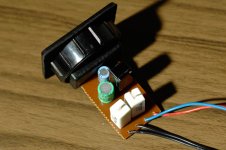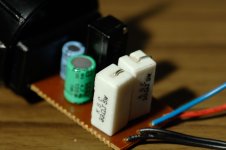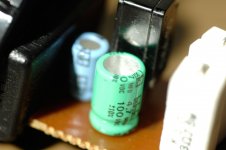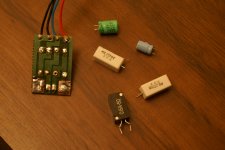Hi Guys:
I have a question for you. I am looking at the Erse 2 way crossovers sold by Simplyspeakers that look very much like the Dayton sold by Parts-express. I think they are the same thing. They both have a jumper in the low pass to adjust it depending on the impedance of the woofer, 4 Ohms or 8 Ohms. Now, here is my question, when the jumper is at the 4 Ohms setting and a 4 Ohms woofer is used, the crossover point remains the same or becomes double?. If I get a 2500hz and I use it with a 4 Ohms woofer and set the jumper to 4 Ohms, will the crossover point remain at 2500hz or will it increase to 5000hz?.
Thank you very much.
I have a question for you. I am looking at the Erse 2 way crossovers sold by Simplyspeakers that look very much like the Dayton sold by Parts-express. I think they are the same thing. They both have a jumper in the low pass to adjust it depending on the impedance of the woofer, 4 Ohms or 8 Ohms. Now, here is my question, when the jumper is at the 4 Ohms setting and a 4 Ohms woofer is used, the crossover point remains the same or becomes double?. If I get a 2500hz and I use it with a 4 Ohms woofer and set the jumper to 4 Ohms, will the crossover point remain at 2500hz or will it increase to 5000hz?.
Thank you very much.
Hi Guys:
I have a question for you. I am looking at the Erse 2 way crossovers ...
Now, here is my question, when the jumper is at the 4 Ohms setting
and a 4 Ohms woofer is used, the crossover point remains the same
or becomes double?. ?.
Thank you very much.
In theory for the LP X-over point:
4 ohms woofer, jumper 4 ohms, Fc= 2500 Hz
8 ohms woofer, jumper 8 ohms, Fc= 2500 Hz
Why not have a proper crossover at least simulated based on driver data? At least it would be a lot closer to ideal than throwing a one-size-fits-nothing pre-made unit at the problem.
I'd be happy to give a simulation a go if you are interested.. I've found that you can often build a decent x-over that is specific to YOUR drivers from good quality components for less than the cost of those off the shelf pre-made units.
I'd be happy to give a simulation a go if you are interested.. I've found that you can often build a decent x-over that is specific to YOUR drivers from good quality components for less than the cost of those off the shelf pre-made units.
Thanks, and more details...
Thank you all for your help. Here, I'll give you more details. Few weeks ago I purchased a Topping TP-60 amplifier. I had a pair of Cerwin Vega D-1 speakers I purchased 20 years ago but never used, I kept them in their original boxes until now. I wanted to use my new amplifier with these speakers since they are 4 Ohms speakers, even though Cerwin Vega specifications say 8 Ohms. I got them out of their boxes and connected them to the TP-60, they are in excellent condition, surrounds, everything is great because they were never used, but I didn't like the sound they produce, so I came here to ask if it would be possible to change the OEM crossovers with something else that would make them sound better. The answer I got was no. Anyhow, after that I decided to leave them alone and just get used to their sound, but few days ago I discovered that the tweeter in one of them was not sounding, and the one in the other was distorting and at medium/high volume levels would go on and off. At first I thought the tweeters were fried, but I took them off and connected them directly to the amplifier's outputs and try them at low volume and both sound perfect. The woofers sound perfect, so I figured it was the crossovers. Before I just wanted to replace them to see if I could improve the quality of sound, now I have because they went bad. I was checking and saw those I mention in SimplySpeakers.com and parts-express.com that have the jumper for the low pass filter. I don't know much about this, but they look better than the OEM crossovers that came with the speakers, the original crossovers look pretty cheap and basic, I believe I paid about $190 for these back in the 90's when I bought them, my guess is that CW installs something OK and production cost has a lot to do with it, but perhaps installing a crossover with better components could improve the sound they produce, and now I am forced to install something since they don't work. Right now I'm using my TP-60 with a pair of B&W DM-220 and the sound is beutiful, what a difference, I know that the CW will never produce the same sound, but in my opinion all they need to sound a little better is more separation, they sound muddy, the bass is much stronger than the high frequencies, so the sound is flat, the DM-220 in the other hand sound great, I can hear clearly all instruments, very clean. Can you help me?. I still want to fix the CW D-1, and improve them if possible.
Thank you again.
Thank you all for your help. Here, I'll give you more details. Few weeks ago I purchased a Topping TP-60 amplifier. I had a pair of Cerwin Vega D-1 speakers I purchased 20 years ago but never used, I kept them in their original boxes until now. I wanted to use my new amplifier with these speakers since they are 4 Ohms speakers, even though Cerwin Vega specifications say 8 Ohms. I got them out of their boxes and connected them to the TP-60, they are in excellent condition, surrounds, everything is great because they were never used, but I didn't like the sound they produce, so I came here to ask if it would be possible to change the OEM crossovers with something else that would make them sound better. The answer I got was no. Anyhow, after that I decided to leave them alone and just get used to their sound, but few days ago I discovered that the tweeter in one of them was not sounding, and the one in the other was distorting and at medium/high volume levels would go on and off. At first I thought the tweeters were fried, but I took them off and connected them directly to the amplifier's outputs and try them at low volume and both sound perfect. The woofers sound perfect, so I figured it was the crossovers. Before I just wanted to replace them to see if I could improve the quality of sound, now I have because they went bad. I was checking and saw those I mention in SimplySpeakers.com and parts-express.com that have the jumper for the low pass filter. I don't know much about this, but they look better than the OEM crossovers that came with the speakers, the original crossovers look pretty cheap and basic, I believe I paid about $190 for these back in the 90's when I bought them, my guess is that CW installs something OK and production cost has a lot to do with it, but perhaps installing a crossover with better components could improve the sound they produce, and now I am forced to install something since they don't work. Right now I'm using my TP-60 with a pair of B&W DM-220 and the sound is beutiful, what a difference, I know that the CW will never produce the same sound, but in my opinion all they need to sound a little better is more separation, they sound muddy, the bass is much stronger than the high frequencies, so the sound is flat, the DM-220 in the other hand sound great, I can hear clearly all instruments, very clean. Can you help me?. I still want to fix the CW D-1, and improve them if possible.
Thank you again.
Cerwin Vega D-1 Components
I forgot to mention the components in the Cerwin Vega D-1, I guess you need to know this in order to help me, they have a 8" woofer with a part number in the back, 81W4, and their impedance is actually 3.6 Ohms, I don't have any more details on them, I contacted Cerwin Vega to request the specifics on these components but they never replied back. The tweeters are like this below, sold at parts-express:
Pioneer AHE60-51F 3-1/2" Horn Tweeter 270-050
They are what they call "bullet type horn tweeters", mine read 7.3 Ohms.
Thank you again.
I forgot to mention the components in the Cerwin Vega D-1, I guess you need to know this in order to help me, they have a 8" woofer with a part number in the back, 81W4, and their impedance is actually 3.6 Ohms, I don't have any more details on them, I contacted Cerwin Vega to request the specifics on these components but they never replied back. The tweeters are like this below, sold at parts-express:
Pioneer AHE60-51F 3-1/2" Horn Tweeter 270-050
They are what they call "bullet type horn tweeters", mine read 7.3 Ohms.
Thank you again.
I know that the CW will never produce the same sound, but in my opinion all they need
to sound a little better is more separation, they sound muddy, the bass is much stronger
than the high frequencies, Thank you again.
Would it be too much trouble to take a photo of the X-over assembly ?
If your drivers work just fine without X-over and have their normal DC
resistance values, there may be something wrong with tweeter capacitor.
Regarding fixing these crossovers, the problem is that I have no soldering skills, so that option doesn't look too good for me.
You don't need the skills right now. Why don't you get a decent soldering
iron like Weller Marksman Iron 40 Watt and some soldering wire 60/40
for start. You'll be succesfull after some experimeting. It really isn't that
hard at all.
40 watts is well suited for this kind of work and with optional tips also
great for temperature sensitive electronics. Even if you are going to use
it for a couple of times in your lifetime, IMO it would be well worth it,
much more than buying off the shelf X-overs.
Since you have no C meter, you could ask the person in general electronics
parts shop to have it measured for you, and if proven faulty, there you can
get a new one.
No, I have a multimeter but it lacks the capacitance feature. I was checking at parts-express, they have the capacitors and resistors, but I can't figure out the black rectangular piece that reads KSC on one side and 0.6A-50 on the other, what is it?.
Just try to change it (and/or shunt it), if I am right, and if that's a PTC. Make sure first, with a post of the xover layout. I would give the job to someone else though...More than likely an inductor. Also more than likely the resistors would blow first.
Last edited:
Thank you!
Hi:
I just wanted to thank you all very much for your help. I decided to take your advice, I purchased a 30W soldering, then I purchased a 45W one (the 35W was kind of weak), and desoldered the capacitors and resistors from the crossover's board.
I am getting new capacitors and resistors to fix these crossovers.
I have been trying soldering and desoldering with some old boards I have laying around, basically video cards and network cards from old computers and I really like it.
As soon as I fix the crossovers I will post the pictures here.
I also bought a couple of amplifier boards from eBay, they are XY brand and come complete with everything needed to build an amplifier based on the LM3886 IC. These are DIY boards, so I want to practice as much as I can before they get here.
I am attaching a picture of the crossover's board and its components desoldered.
Again, thank you ALL very much for your help.
Hi:
I just wanted to thank you all very much for your help. I decided to take your advice, I purchased a 30W soldering, then I purchased a 45W one (the 35W was kind of weak), and desoldered the capacitors and resistors from the crossover's board.
I am getting new capacitors and resistors to fix these crossovers.
I have been trying soldering and desoldering with some old boards I have laying around, basically video cards and network cards from old computers and I really like it.
As soon as I fix the crossovers I will post the pictures here.
I also bought a couple of amplifier boards from eBay, they are XY brand and come complete with everything needed to build an amplifier based on the LM3886 IC. These are DIY boards, so I want to practice as much as I can before they get here.
I am attaching a picture of the crossover's board and its components desoldered.
Again, thank you ALL very much for your help.
Attachments
If you look VEEEERY closely to the enlarged size photo of the Dayton crossover you will notice two leads out of each end of the inductor.
I believe that the inductor has a tap at half value and full value.
The capacitors for the low pass are doubled up.
If you choose 4 ohm it uses the low value tap and two capacitors.
If you choose the 8 ohm it uses the high value tap and only one capacitor.
That's the closest I can tell.
I believe that the inductor has a tap at half value and full value.
The capacitors for the low pass are doubled up.
If you choose 4 ohm it uses the low value tap and two capacitors.
If you choose the 8 ohm it uses the high value tap and only one capacitor.
That's the closest I can tell.
- Status
- This old topic is closed. If you want to reopen this topic, contact a moderator using the "Report Post" button.
- Home
- Loudspeakers
- Multi-Way
- Crossover point and Impedance.



